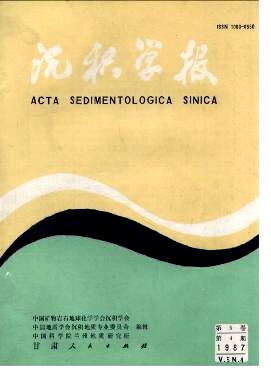DEBRIS FLOW SEDIMENTS OF SANDY CLASTIC ON THE GENTLE SLOPE AREA OF PRODELTA IN OLIGOCENE, DONGYING BASIN
- Received Date: 1985-09-01
- Publish Date: 1987-12-10
Abstract: The 3rd Member of Shahejie Formation Oligocene is the sediments during the deep depressing period of Dongying Basin, Shandong Province. At that time, the basin centre was a west-dip gentle slope of prodelta where a dark mudstone with maximum thickness up to 600 meters was deposited. A lot of elongate and/or lenticular clastic rock bodies have been discoveried in this set of dark mudstone. The studies based on drilling data indicate that the lithological characters of the clastic rock body are as following:( 1 ) It predominantly is sandstone with intraclastic texture and mud-block silt-block rudstone and mud-block grain rock with intraclastic texture as well as dolosiltite, and it is common that angular and stripped argillaceous rent block mixed into these rocks.( 2 ) When the mud is more contentrative(forming argillaceous rent block,especially thin interbeds), the rhyotaxitic structure in the mud is common.( 3 ) The rhythm of the rock consists of the rigid raft in the upper part and the laminar flow zone in the lower part. All the characters indicate that sediments are transported and deposited by cohesive plastic(Bingham substance) flow(namely, debris flow). Based on sedimentary characters, the intraclastic debris folws in the prodelta can be subdivided into sandy debris flow, silty debris flow, carbonate debris flow and argillaceous debris flow. Based on fabric and lithologic characters, the rhythm of the preceding three debris flows can be divided into five division: floating mud-block rudite division, mixed seriate rudite division, parallel fabric division, flow laminae division and pillow lump division. The rhythm of argillaceous debris flow sediments can be divided into three division: sliding sand lump and mud-block division, rhyotaxitic structure division and pillow lump division. The floating mud-block rudite division and the mixed seriate rudite division(sliding sandy lump and mudb-lock division) are just the rigid raft(plug flow) in the division of rheology, and the parallel fabric division and flow laminae division(rhyotaxitic structure division) are just the laminar flow zone. The formation of these debris flows are caused by the fast depositional rate and the unstability the sediments in the high-constructive delta area. The river mouth bar and the far bar with sediments of higher specific gravity prograded and deposited on soft argillaceous sediments with lower specific gravity deposited originally in a prodelta. Such a unstability of gravity resulted in slide which evolved to debris flow. There are necessary conditions for the formation of debris flow in the high-constructive delta. The oil exploration in Dongying Basin indicated that the debris flow clastic rock body distributed broadly in the gentle slope area of prodelta. The sandy debris flow sediments, with lower mud content, higher porosity and permeability, high pressure(in the abnormal high pressure zone), appeared to be very well in oil prospect, and to be an important object for explorating occult oil reservoir.
| Citation: | Wang Deping, Liu Shouyi. DEBRIS FLOW SEDIMENTS OF SANDY CLASTIC ON THE GENTLE SLOPE AREA OF PRODELTA IN OLIGOCENE, DONGYING BASIN[J]. Acta Sedimentologica Sinica, 1987, 5(4): 14-24. |






 DownLoad:
DownLoad: